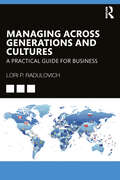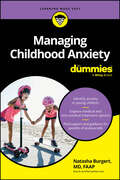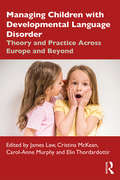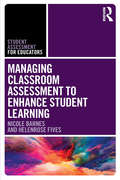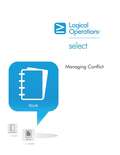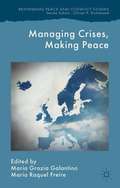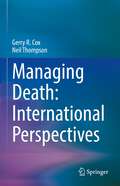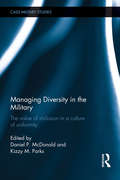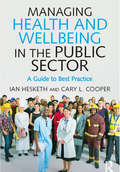- Table View
- List View
Managing ADHD Workbook for Women: Exercises and Strategies to Improve Focus, Motivation, and Confidence
by Beata Lewis Christy Duan Kathleen Fentress TrippFind focus and feel more in control with this ADHD guide for womenWomen with ADHD face unique challenges, but there are proven ways to understand and manage ADHD in your daily life. This ADHD workbook for adults breaks down the symptoms of ADHD, with strategies for navigating the ones that might be holding you back and emphasizing what makes you feel confident and capable.Skill-building exercises—Learn simple ways to improve practical skills like time management and organization, as well as emotional skills like acceptance and self-esteem.Relatable stories—Find inspiration in stories from other women with ADHD and how they've used these tips to succeed personally and professionally.Support for all women—This advice is designed to be useful no matter your age, your lifestyle, or what age you were diagnosed.Learn how to embrace adult ADHD with evidence-backed tips and activities that can help you achieve your goals.
Managing Across Generations and Cultures: A Practical Guide for Business
by Lori RadulovichDevelop powerful leadership skills with this concise guide to managing multigenerational and culturally diverse teams. Assess your leadership competencies using eight proven questionnaires that target critical areas for improvement. Build leadership credibility, communicate persuasively, and foster collaboration to drive higher team performance using the practical recommendations provided for each leadership trait.Today, managers face the daunting challenge of leading multigenerational teams from globally diverse cultures. This handbook provides specific steps to develop leadership competencies that create self-driven, high-performing teams by breaking down generational and cultural barriers. Measure your leadership competence with eight self-assessments and learn to: Build Leadership Credibility: Discover your leadership style and the key qualities of great leaders. Learn how to make better decisions, improve outcomes, and navigate conflict when facing adversity Communicate Persuasively and Impactfully: Identify your communication style and the message you reveal through words and body language. Learn to communicate clearly in complex cultural contexts and influence outcomes with data visualization and persuasion techniques Create High-Performing Teams: Bridge generational and cultural differences by sharing knowledge and skills to reverse biases, build trust, increase cultural sensitivity, and learn about global markets Lead Global Teams: Discover how managers leverage resources and nurture innovation for global expansion. Learn which industries exhibit accelerated internationalization and why After completing the self-assessments, you’ll create an Individual Development Plan by selecting specific recommendations to shore up skills and track your progress using the included Leadership Guiding Values Scorecard. Leaders and managers at all levels of seniority and across industries, as well as MBA students, will be inspired to build their leadership career path with insight and confidence using the concise review of global leadership topics and thoughtful recommendations presented in this handbook.
Managing Anxiety in School Settings: Creating a Survival Toolkit for Students
by Anna Duvall Crissy RoddyManaging Anxiety in School Settings dives into the growing topic of anxiety and its implications on students’ emotional and academic wellbeing, providing key insights into how to enable students to be successful inside and outside of the classroom. This book provides the reader with a tangible set of strategies for all grade levels that can be built into individualized anxiety survival toolkits for students to deploy discreetly and effectively both in the classroom and in their daily lives. With real-life examples from Anxious Annie in each chapter, readers build a grounded, fine-grained understanding of anxiety’s causes, different varieties, manifestations, social and learning impacts, and coping strategies. Breakdowns by grade level take into account which strategies your students will be most open to and best served by. School counselors and teachers can use this book to work with students individually, in small groups, classes, or even entire schools to create anxiety survival toolkits to provide practical strategies that help students combat their anxiety for the rest of their lives.
Managing Challenging Behaviour Following Acquired Brain Injury: Assessment, Intervention and Measuring Outcomes (Neuropsychological Rehabilitation: A Modular Handbook)
by Andrew Worthington Nick AldermanThis empirically based book provides conceptual knowledge and practical advice to enable clinicians to implement evidence-based methods drawn from learning theory for managing the catastrophic effects of challenging behaviour as an enduring outcome of acquired brain injury (ABI). Based on a conceptual framework of neurobehavioural disability, the book takes a holistic case formulation approach, incorporating functional assessment procedures arising from the operant learning tradition that underpins the design of treatment interventions. It bridges the knowledge gap in uniquely providing a single resource to enable practitioners to implement evidence-based methods to better manage ABI behaviour disorders. The authors, who are leading experts in the field, have described a model of intervention based on a functional analytic approach to understanding behaviour within an operant learning framework. The chapters provide a step-by-step approach to assessment, formulation, intervention and evaluation of behaviour support plans, and feature examples for specific challenging behaviours in a variety of different contexts. The book is organised to support the use of this model through expert contributions concerning the origins of challenging behaviour, assessment methods and formulation, and interventions. The practical orientation of this book makes it an indispensable read for neuropsychologists, clinical psychologists and other rehabilitation specialists involved in the care of people with ABI as well as researchers in these fields.
Managing Childhood Anxiety For Dummies
by Natasha BurgertUnderstand what child anxiety is, how to treat it, and how to support and encourage anxious children Anxiety is the most common mental health condition in young children. Managing Childhood Anxiety For Dummies is the go-to resource for parents of young children who suspect their child may be experiencing anxiety but aren't sure where to start. Learn to recognize the symptoms of anxiety in kids who may be too young to explain how they're feeling and get expert advice on supporting them with proper treatment and guidance. Find answers to questions like: When is worry normal, and when it is a sign of anxiety? Which interventions are most effective for anxious kids? How can I make my home or classroom less stress inducing? Written by an experienced pediatrician, this compassionate book challenges harmful taboos about mental health and equips you with the tools you need to be a resource to any young child with anxiety. Learn the basics of childhood anxiety and how it's diagnosed Explore ways to diagnosis anxiety, treat it with proven methods, and manage the physical symptoms that often come with childhood anxiety Find helpful tips to create a supportive environment at home and school to foster your young child's growth and development Discover effective and positive strategies to help your anxious child with sleep, screen time, and sports performance Managing Childhood Anxiety For Dummies provides essential information to assist you in supporting the children in your care. It's also invaluable for all parents and caregivers of children aged 4-11 years who have concerns about a child's persistent worrying.
Managing Children with Developmental Language Disorder: Theory and Practice Across Europe and Beyond
by James Law Cristina McKean Carol-Anne Murphy Elin ThordardottirAlthough most children learn language relatively quickly, as many as 10 per cent of them are slow to start speaking and are said to have developmental language disorder (DLD). Children with DLD are managed by a variety of different professionals in different countries, are offered different services for different periods of time and are given a variety of different therapeutic treatments. To date, there has been no attempt to evaluate these different practices. Managing Children with Developmental Language Disorder: Theory and Practice Across Europe and Beyond does just this, reporting on the findings of a survey carried out as part of the work of COST Action IS1406, a European research network. Law and colleagues analyse the results of a pan-European survey, looking at how different services are delivered in different counties, at the cultural factors underpinning such services and the theoretical frameworks used to inform practice in different countries. The book also provides a snapshot of international practices in a set of 35 country-specific "vignettes", providing a benchmark for future developments but also calling attention to the work of key practitioners and thinkers in each of the countries investigated. This book will be essential reading for practitioners working with children with language impairments, those commissioning services and policy in the field and students of speech and language therapy.
Managing Classroom Assessment to Enhance Student Learning (Student Assessment for Educators)
by Helenrose Fives Nicole BarnesAs teachers are required to integrate an increasing number of assessment practices into the classroom, it is crucial that they have effective routines for organizing and evaluating the generated data. Managing Classroom Assessment to Enhance Student Learning introduces pre- and in-service teachers to the major categories of assessment management and provides empirical and theoretical support for their effectiveness. In-depth chapters consider management in the context of assigning and collecting work, interpreting and organizing assessment results, and providing students with feedback.
Managing Clinical Risk: A Guide to Effective Practice
by Caroline Logan Lorraine JohnstoneThe second edition of Managing Clinical Risk is an authoritative guide on how to engage in risk assessment and management practice in evidence-based, accountable and effective ways. Over the course of a dozen chapters, each oriented around a brief case study reflecting a different area of risk, practitioners are offered guidance on how to read referrals, how to decide what information matters to their evaluations, how to speak to a person who may be reluctant to engage in an assessment of this kind, how to organise the information they have gathered in order to prepare a risk formulation that will in turn guide risk management, and how to communicate opinions and recommendations in ways that have an impact. The book provides an evidence-based understanding of risk assessment and management in key areas of practice – violence, sexual violence, suicidal and self-harmful behaviour, as well as family and relationship violence, organised criminal and group-based violence, and violent extremism. Practices relevant to understanding violent behaviour in individuals are contrasted with those better suited for working with groups and organisations. How practitioners can take account of the diversity of the clients with whom they work is a central consideration in every chapter. And helping practitioners develop the skills to enable them to formulate risk where there may be multiple areas of concern is a key objective of this book. All the contributors to this updated guide to effective practice are scholar-practitioners – experienced professionals with a track record of writing and teaching about risk assessment and management practice in their respective fields. Therefore, this book contains realistic rather than idealistic representations of the work required to prevent harmful behaviour by the kinds of clients they work with. Together, contributors combine theoretical and research knowledge with a wealth of practical skills, emphasising the collaborative and recovery-focused nature of modern risk management.
Managing Conflict
by David Fulle Bethany SnyderThis book will assist you in understanding and implementing strategies that will help to manage conflict effectively.
Managing Conflict in the Family Business
by Kent Rhodes David LanskyFamily Business Conflict Archetypes, Frames, Roles, and Tactics are discussed in this book with a view toward educating readers to the common conflict cycles that family businesses encounter. More specifically the book will address twelve conflicts that are common in family owned businesses, how to spot them and how to resolve them.
Managing Conflict through Communication
by Dudley D. Cahn Ruth Anna AbigailManaging Conflict Through Communication helps students approach conflict constructively and learn more positive conflict management and resolution skills.
Managing Crises, Making Peace
by Maria Raquel Freire Maria Grazia GalantinoThe EU has increased its commitment in response to crises, however, in the face of new threats and emerging crises, its capacity to build a distinctive role in crisis management remains problematic. Resurging divergences in major member states' positions, requiring dual adaptation of the EU level of governance with the national projection of interests, are posing a serious challenge to the objective of a more integrated European defense and security strategy. This collection offers valuableinsights for understanding how a distinctive EU vision on peace missions has emerged and whether it is there to last. Bringing an innovative perspective to European Union engagement in peace operations, this volume combines theoretical reflection with the analysis of empirical case studies that illustrate not only the EU's action in the framework of its Common Security and Defense Policy (CSDP), but also how it engages with other actors in the field including international organisations, non-governmental organisations and local citizens.
Managing Death: International Perspectives
by Neil Thompson Gerry R. CoxThere is a huge collection of literature relating to death, grief and bereavement, but one aspect that has received relatively little attention is that of death management practices (by which we mean the various ways of managing the circumstances of the death, ritually acknowledging it and sensitively handling the disposal of the body and so on). While ways of disposing of the dead and grief practices have been thought of as based upon individual responses, grief and bereavement practices can be understood not only by looking at psychological and medical frameworks, but also by examining people as part of a complex structure of social arrangements, institutions, structures, and patterns. By examining the social and institutional structures of various groups around the world, we provide an international framework for a better understanding of the study of dying, death, and bereavement.This book highlights the significance of these matters in an international context, reflecting common themes and important differences. It will highlight common themes across diverse cultures and national settings, while also drawing attention to significant differences. If professionals working in the field of death, grief and bereavement are not aware of such differences, their practice can be insensitive, discriminatory and therefore ineffective, if not actually counterproductive. As such, the book provides an invaluable resource for a wide variety of professionals and students, including medicine and health care; social work; counselling and psychotherapy; chaplaincy and pastoral work; and, of course, those involved in the funeral industry. In addition, students of sociology, psychology and anthropology will find much of interest here in terms of appreciating the diversity of ways in which funerals and other death management practices are managed and integrated into social life.
Managing Depression in Clinical Practice
by Edward S Friedman Ian M AndersonAn estimated 21 million people are diagnosed each year with a major depressive disorder in the USA, Western Europe and Japan. The economic cost of depression and its impact on sufferers and those around them is enormous. There are numerous therapy choices available, which can be daunting for the clinician trying to achieve the best treatment regimen. Managing Depression in Clinical Practice provides a concise overview of the clinical manifestation, diagnosis and management of this debilitating condition. The book gives practical coverage of depression in special populations, the management of treatment non-response and long-term treatment. Managing Depression in Clinical Practice is intended as an accessible text for family practitioners and psychiatrists in training and in practice. It will also be of interest to specialist nurses and allied health professionals working in the field.
Managing Depression, Growing Older: A guide for professionals and carers (Black Dog Ser.)
by Gordon Parker Henry Brodaty Kerrie EyersAwarded the book prize for 2012 by the Australasian Journal on Ageing! Even when he’s grey around the muzzle, the black dog of depression can still deliver a ferocious bite. Depression can strike at any age, and it may appear for the first time as we get older, as a result of life circumstances or our genetic makeup. While older people face the same kinds of mental health issues as younger people, they can find it more difficult to deal with them owing to the stressors which accumulate with age. There is also a high incidence of undiagnosed depression in older age, presenting extra challenges for carers. Managing Depression Growing Older offers a systematic guide to identifying depression in older people, supporting them at home or in an aged care setting, and the importance of diet, exercise and attitude in recovery. It is essential reading for anyone who works with the elderly.
Managing Difficult Endings in Psychotherapy: It's Time (United Kingdom Council For Psychotherapy Ser.)
by Lesley MurdinThis book is about the difficulty of endings, but it is also about learning from the endings that we know have gone wrong as well as those that have worked well. It sets out how the psychological therapist can help a person to live well while life is available, and to face the endings that confront all of us with honesty, and the acceptance of our human fragility. Therapists suffer through the fears and failures of the people they see as well as through their own endings. These difficulties can either help each one to be more understanding and helpful, or can lead to disaster. This book is about making sure that we use experience as well as theory constructively.
Managing Diversity in the Military: The value of inclusion in a culture of uniformity (Cass Military Studies)
by Daniel P. McDonald Kizzy M. ParksThis edited book examines the management of diversity and inclusion in the military. Owing to the rise of asymmetric warfare, a shift in demographics and labor shortfalls, the US Department of Defense (DoD) has prioritized diversity and inclusion in its workforce management philosophy. In pursuing this objective, it must ensure the attractiveness of a military career by providing an inclusive environment for all personnel (active and reserve military, civilian, and contractors) to reach their potential and maximize their contributions to the organization. Research and practice alike provide substantial evidence of the benefits associated with diversity and inclusion in the workplace. Diversity and inclusion programs are more strategic in focus than equal opportunity programs and strive to capitalize on the strengths of the workforce, while minimizing the weaknesses that inhibit optimal organizational performance. This new book provides vital clarification on these distinct concepts, in addition to offering concrete best practices for the successful management of diversity and inclusion in the workplace. Written by scholars and practitioners, each chapter addresses major areas, raises crucial issues, and comments on future trends concerning diversity and inclusion in the workplace. The book will be of great interest to students of military studies, war and conflict studies, business management/HRM, psychology and politics in general, as well as to military professionals and leaders.
Managing Emergent Phenomena: Nonlinear Dynamics in Work Organizations
by Stephen J. GuastelloChaos, catastrophe, self-organization, and complexity theories (nonlinear dynamics) now have practical and measurable roles in the functioning of work organizations. Managing Emergent Phenomena begins by describing how the concept of an organization has changed from a bureaucracy, to a humanistic and organic system, to a complex adaptive system. The dynamics concepts are then explained along with the most recent research methods for analyzing real data. Applications include: work motivation, personnel selection and turnover, creative thinking by individuals and groups, the development of social networks, coordination in work groups, the emergence of leaders, work performance in organizational hierarchies, economic problems that are relevant to organizations, techniques for predicting the future, and emergency management. Each application begins with a tight summary of standard thinking on a subject, followed by the new insights that are afforded by nonlinear dynamics and the empirical data supporting those ideas. Unusual concepts are also encountered, such as the organizational unconscious, collective intelligence, and the revolt of the slaved variables. The net results are a new perspective on what is really important in organizational life, original insights on familiar experiences, and some clear signposts for the next generation of nonlinear social scientists.
Managing Fear: The Law and Ethics of Preventive Detention and Risk Assessment (International Perspectives on Forensic Mental Health)
by Bernadette McSherryManaging Fear examines the growing use of risk assessment as it relates to preventive detention and supervision schemes for offenders perceived to be at a high risk of re-offending, individuals with severe mental illness, and suspected terrorists. It outlines a number of legislative regimes in common law countries that have broadened ‘civil’ (as opposed to criminal) powers of detention and supervision. Drawing on the disciplines of criminology and social psychology, it explores how and why such schemes reflect a move towards curtailing liberty before harm results rather than after a crime has occurred. Human rights and ethical issues concerning the role of mental health practitioners in assessing risk for the purposes of preventive detention and supervision are explored, and regimes that require evidence from mental health practitioners are compared with those that rely on decision-makers’ notions of ‘reasonable belief’ concerning the risk of harm. Case studies are used to exemplify some of the issues relating to how governments have attempted to manage the fear of future harm. This book aims to educate mental health practitioners in the law relating to preventive detention and supervision schemes and how the legal requirements differ from clinical assessment practices; examine the reasons why there has been a recent renewal of preventive detention and supervision schemes in common law countries; provide a comparative overview of existing preventive detention and supervision schemes; and analyse the human rights implications and the ethics of using forensic risk assessment techniques for preventive detention and supervision schemes.
Managing Future Challenges for Safety: Demographic Change, Digitalisation and Complexity in the 2030s (SpringerBriefs in Applied Sciences and Technology)
by Corinne Bieder Hervé Laroche Jesús Villena-LópezThis open access book addresses the future of work and industry by 2040—a core interest for many disciplines inspiring a strong momentum for employment and training within the industrial world. The future of industrial safety in terms of technological risk-management, although of obvious concern to international actors in various industries, has been quite sparsely addressed. This brief reflects the viewpoints of experts who come from different academic disciplines and various sectors such as oil and gas, energy, transportation, and the digital and even the military worlds, as expressed in debates and discussions during a two-day international seminar. The contributors address such questions as:What influence will ageing and lack of digital skills in the workforce of the occidental world have on safety culture?What are the likely impacts of big data, artificial intelligence and autonomous technologies on decision-making, and on the roles and responsibilities of individual actors and whole organizations?What role have human beings in a world of accelerating changes?What effects will societal concerns and the entrance of new players have on technological risk management and governance?Managing Future Challenges for Safety will interest and influence researchers considering the future effects of a number of currently developing technologies and their practitioner counterparts working in industry and regulation.
Managing Health and Wellbeing in the Public Sector: A Guide to Best Practice
by Cary L. Cooper Ian HeskethAs governments throughout the world experience increasing fiscal challenges, the pressures on public sectors to streamline services and harness technological advances is unprecedented. Many have undergone huge budgetary cuts as a result, but what are the effects of this intense organisational change on such a large and varied workforce? And how can managers within the public sector meet the challenge of delivering services whilst maintaining the health and wellbeing of staff tasked with carrying out the work? Managing Health and WellBeing in the Public Sector: A Guide to Best Practice is the ideal companion to any manager in these challenging times. Exploring the realities of working in the public sector, and those factors which can add meaning and purpose to working life, the book provides managers with a practical toolkit for creating the best working environment, as well as nurturing resilience and motivation within their staff. Written by two authors with a lifetime of experience in the field, the book also examines why promoting occupational health and wellbeing is beneficial to organizations, drawing on a wealth of international research to support this argument. It concludes with a series of case studies in which an international range of public sector managers discuss initiatives they have implemented, and how successful they have been. This is the ideal companion for any manager working in the public sector. It will also be instructive reading for students or researchers of occupational or organizational psychology, as well as HRM.
Managing Health, Safety and Well-Being: Ethics, Responsibility And Sustainability (Aligning Perspectives On Health, Safety And Well-being Ser.)
by Stavroula Leka Aditya Jain Gerard I.J.M. ZwetslootTo achieve sustainable progress in workplace and societal functioning and development, it is essential to align perspectives for the management of health, safety and well-being. Employers are responsible for providing every individual with a working environment that is safe and does not harm their physical or mental health. However, the current state of the art indicates that approaches used to promote health, safety and well-being have not had the anticipated results. At the level of the enterprise it is widely understood and accepted by all stakeholders that employers share the responsibility of promoting and managing the health of their workers. Evidence indicates that most employers put in place procedures and measures to manage workers’ health and create healthy workplaces to meet legal requirements, as a response to requests by employees, as a need to improve company image/reputation, and to improve productivity. This highlights that in addition to legal requirements, the key drivers for companies also include the ethical and business case. While much has been written about role of legislation and the business case for promoting health, safety and well-being, not much is known about the ‘ethical case’ for promoting employment and working conditions. In this context, this book examines the potential of the link between responsible and sustainable workplace practices, human rights and worker health, safety and well-being and explores how complementary approaches can be used to promote employment and working conditions and sustainability at the organizational level. It offers a framework for aligning different approaches and perspectives to the promotion of workers’ health, safety and well-being and provides recommendations for introducing such an approach at the enterprise level.
Managing High Risk Sex Offenders in the Community: A Psychological Approach
by Jackie CraissatiHow can a psychological framework improve the success of risk management? The management of sex offenders in the community is of paramount concern to the general public, and this is reflected in the numberous recent changes to public protection procedures. Managing High Risk Sex Offenders in the Community covers both the assessment and management of high risk sex offenders in the community, with an emphasis on evidence-based approaches. The reader will be able to access the most widely used actuarial approaches to risk assessment and understand the clinical themes that underpin such variables. The book answers questions including: * Are sex offenders likely to escalate their behaviour if not stopped? * Is the risk on the streets or at home?* Can we differentiate between those offenders who will and those who will not reoffend? This book links psychologically-based theoretical principles with practical considerations for professionals in the field. By demystifying the current state of knowledge on risk posed by sex offenders, practitioners will be well placed to engage in defensible decision-making and strive for best practice in the community.
Managing Hot Flushes and Night Sweats: A Cognitive Behavioural Self-help Guide to the Menopause
by Melanie Smith Myra HunterThis revised edition of Managing Hot Flushes and Night Sweats offers up to date and evidence-based information about the menopause and about hot flushes and night sweats, which are the main reason that women seek medical help. The four-week self-help guide uses cognitive behavior therapy providing information and strategies for managing hot flushes and night sweats, as well as stress and sleep. The guide is interactive with exercises and homework tailored to women’s individual circumstances and lifestyles. It challenges myths about menopause and aging and provides better understanding of flushes which in turn reduces stress and improves post-menopausal wellbeing. The various chapters discuss processes of identification and modification of triggers of hot flushes and offers tips to women on dealing with hot flushes in social and work situations. The guide was as effective as eight hours of group CBT and would help women who want to try a non-medical treatment that is brief, effective without side effects, or just want to be better informed.
Managing Hot Flushes and Night Sweats: A cognitive behavioural self-help guide to the menopause
by Melanie Smith Myra HunterThe menopause is still a taboo topic and a source of uncertainty and embarrassment for many women. In Managing Hot Flushes and Night Sweats Myra Hunter and Melanie Smith aim to provide women with up to date and balanced information about menopause and a self-help guide to reduce the impact of hot flushes and night sweats in just four weeks. This book sets out an interactive four-week programme using cognitive behavioural therapy, with exercises and worksheets designed to enable women to develop strategies for managing menopausal symptoms. This approach is based on the authors’ research and has been shown to be effective in recent clinical research trials. This guide can help you to: Understand the biological as well as the psychological and cultural influences on menopause Understand and manage hot flushes in social situations Learn to modify triggers and use paced breathing to reduce the impact of hot flushes Reduce stress and improve well-being Develop strategies to help if night sweats disturb your sleep With a companion audio exercise and downloadable resources available online, Managing Hot Flushes and Night Sweats offers a complete and effective framework to approach menopause with confidence and to manage symptoms without the use of medication. The book is ideal for women approaching or going through the menopause, for women having menopausal symptoms following treatment for breast cancer, for their friends and relatives, and healthcare professionals working with women.

